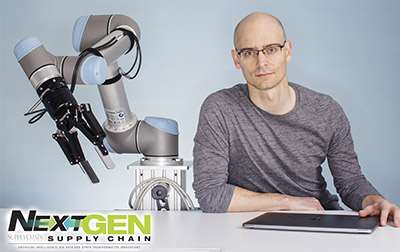 This month we spoke with Pieter Abbeel. For the past several years, he has focused on artificial intelligence as a professor at the University of California at Berkeley. Until a few months ago, Abbeel was also a researcher at Elon Musk's OpenAI lab. He left in October to found Embodied Intelligence with three other researchers from OpenAI and Berkeley. Starting with $7 million of seed money, the company is teaching robots how to pick parts and build assemblies using virtual reality and artificial intelligence, eliminating the need for programming robots traditionally. He can be reached at [email protected].
This month we spoke with Pieter Abbeel. For the past several years, he has focused on artificial intelligence as a professor at the University of California at Berkeley. Until a few months ago, Abbeel was also a researcher at Elon Musk's OpenAI lab. He left in October to found Embodied Intelligence with three other researchers from OpenAI and Berkeley. Starting with $7 million of seed money, the company is teaching robots how to pick parts and build assemblies using virtual reality and artificial intelligence, eliminating the need for programming robots traditionally. He can be reached at [email protected].
NextGen Supply Chain: There are plenty of tech startups out there, but it isn't every day that The New York Times writes a story about one of them less than a month after launch. So, at Embodied Intelligence, you must be trying to do something that's startlingly groundbreaking. If you could get us up to speed here.
Abbeel: What we have here are two novelties that are related but quite separate. At this point, most people don't use the words virtual reality and artificial intelligence together. But we do, and we aren't the only ones doing this.
Traditional robot programming is very time consuming. It's also very limited in its capabilities. You program a specific action or series of actions. But the robot is limited to those activities or range of motions. The robot can't go beyond and perform new tasks without new programming.
We're trying to go beyond this using completely different technologies. For instance, the objective could be to teach the robot how to pick a specific part from a jumble of other parts. We both know the part is not always going to be in the same place or in the same position every time and the clutter around it will be different every time, too. So, we're using VR to first teach the robot the basic action and then use AI to allow the robot to learn on its own how to pick that same part each time no matter what surrounds it. We call that the environment.
We're trying to take robots to the next level in terms of their capabilities. That's what is startlingly groundbreaking, to use your words. Furthermore, it's only recently that AI has advanced enough to make any of this possible.
NextGen Supply Chain: How exactly do VR and AI work together? I'm having a little trouble imagining this, so help me here. It's just so different from how robots work today.
Abbeel: Robots need to be smarter than they are. They need to learn how to react to situations not just perform the same action again and again. They need to adapt to live in their environment. So, we're giving robots eyes. That might be in the form of audio and/or tactile sensors. It can also be eyes as in a vision system.
Let's assume we have a robot with a vision system. And by the way, what we're talking about here is completely robot agnostic. What we are developing sits in the cloud or on local server, guiding any make or model of robot with a vision system, in this instance.
We start with a person wearing an off-the-shelf, commercial VR system. It could be HTC Vive or Oculus or any other make for that matter.
The person holds a teaching pendant and performs the picking action. The neural net learns from these demonstrations how the robot's motion should depend on the configuration of the environment, which will be different every time. The pendant tracks the motion of the person and translates it into a motion learned by the neural net. At this point, the person needs to demonstrate the action 100 to 1,000 times, depending on the environment, for the neural net to collect enough information about the motion.
By the way, it isn't difficult to perform an action 100 or more times in an hour. So this doesn't take much time compared to traditional programming. And we usually have an 80 to 90% success rate.
NextGen Supply Chain: What exactly is the robot learning from this?
Abbeel: While the pedant is tracking the motion, the robot is also being taught how to perform the motion in the environment, which is changing from pick to pick.
This is more than recognizing a part, which vision does today. And it's more than teaching the robot to perform a specific motion, which traditional programming does today.
Using AI, we are teaching the robot to learn how to move as a function of the environment that it is working in. Using machine learning, the robot is able to adapt to the current conditions and pick the part every time regardless of anything else that might be in the way or just plain different. That's what's new here.
NextGen Supply Chain: This is all laboratory work. Right?
Abbeel: Not at all. This is all real-world work. We work very closely with quite a few companies to solve their problems. It's about picking a specific part or item in environments that even people have challenges working within.
Pharma, as well as other industries with shipping and warehousing operations, are very interested in this right now. They see the potential for giving robots a completely different set of skills and how this can do much more than just improve their own operating efficiencies. They and others see the potential for using robots to change how they operate.
At the same time, the technology here is going beyond the armies of PhDs that today program human tasks. We are creating an AI layer that allows robots to learn new tasks in their environment without the need for human programming.
Gary Forger is the special projects editor for Supply Chain Management Review. He can be reached at [email protected].
SC
MR


Latest Supply Chain News
- Tech investments bring revenue increases, survey finds
- Survey reveals strategies for addressing supply chain, logistics labor shortages
- Israel, Ukraine aid package to increase pressure on aerospace and defense supply chains
- How CPG brands can deliver on supplier diversity promises
- How S&OP provides the answer to in-demand products
- More News
Latest Resources

 Explore
Explore
Software & Technology News
- Tech investments bring revenue increases, survey finds
- Survey reveals strategies for addressing supply chain, logistics labor shortages
- AI, virtual reality is bringing experiential learning into the modern age
- Humanoid robots’ place in an intralogistics smart robot strategy
- Tips for CIOs to overcome technology talent acquisition troubles
- Game on: Rethinking change management for the digital era
- More Software & Technology
Latest Software & Technology Resources

Subscribe

Supply Chain Management Review delivers the best industry content.

Editors’ Picks





